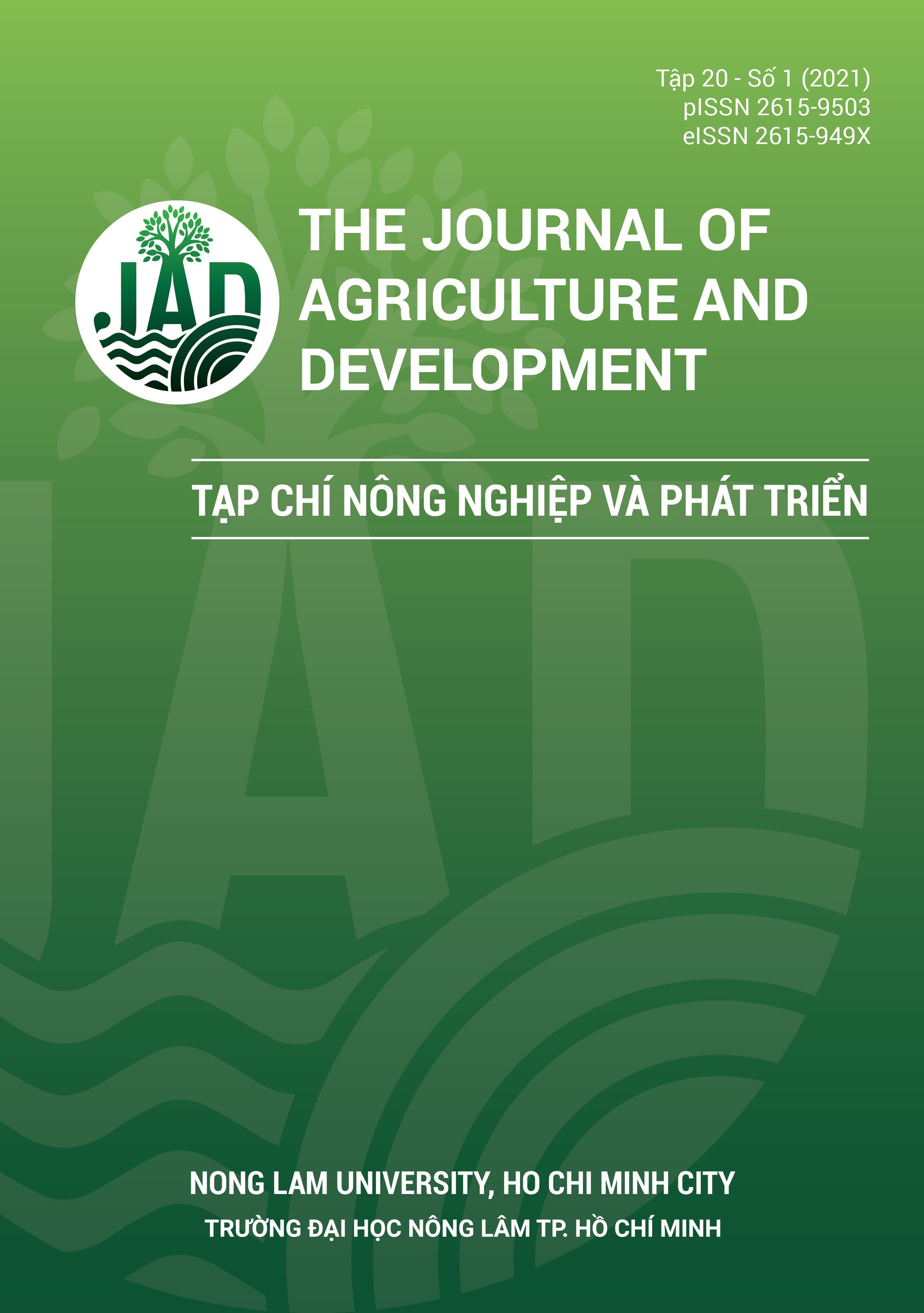Genetic parameter estimates for important traits on the fifth generation in red tilapia in Vietnam
Main Article Content
Abstract
Genetic parameters comprising heritability, genetic correlation and geno-type by environment interaction (GxE) for growth survival rate and body colour at harvest were estimated on the 5th selective generation of red tilapia grown in two environments, freshwater and brackishwater ponds. A total of 116 full- half-sib families was produced as well as 4,432 and 3,811 tagged individuals were tested in freshwater and brackishwater ponds, respectively. Genetic parameters were estimated by ASReml 4.1 software. The heritability for body weight and survival rate was high while medium heritability for body colour in freshwater was observed. The heritability for those traits of red tilapia in brackishwater. Together with the figures in earlier publication on previous generations (G1 to G4) in the same selective population, the expected medium to high re-sponse acquires if selection is done for each trait. Genetic correlations among harvest body weight, survival rate and body colour are insignifi-cantly different and ranging from -0.25 to 0.37 (P > 0.05). These results implied that selection on one trait do not influence on responses of the other traits. GxE interaction for body weight and body colour between two tested environments is mostly negligible with genetic correlations ranging from 0.63 - 0.80 while it is important for survival trait (rg= -0.17±0.40).
Article Details
References
Bentsen, H. B., Gjerde, B., Nguyen, N. H., Rye, M., Pon- zoni, R. W., Palada de Vera, M. S., Bolivar, H. L., Velasco, R. R., Danting, J. C., Dionisio, E. E., Longa- long, F. M., Reyes, R. A., Abella, T. A., Tayamen, M. M., & Eknath, A. E. (2012).Genetic improvement of farmed tilapias: Genetic parameters for body weight at harvest in Nile tilapia (Oreochromis niloticus) during five generations of testing in multiple environments. Aquaculture 338-341, 56-65. https://doi.org/10.1016/j.aquaculture.2012.01.027
Gilmour, A. R., Gogel, B. J., Cullis, B. R., Welham, S. J., & Thompson, R. (2015). ASReml user guide release 4.1 structural specifcation. Hemel Hempstead, England: VSN International.
Gjerde, B. (2005). Design of breeding programs. In Gjedrem, T. (Ed.). Selection and breeding programs in aquaculture (73-195). Heidelberg, Netherlands: Springer. https://doi.org/10.1007/1-4020-3342-7_12
Nguyen, H. N., Hamzah, A., & Thoa, N. P. (2017). Effects of genotype by environment interaction on genetic gain and genetic parameter estimates in red tilapia (Oreochromis spp.). Frontiers in Genetics 8, 82. https://doi.org/10.3389/fgene.2017.00082
Nguyen, H. V. (2021). “Mighty eagerness” in the version for the lunar new year. Vietnam Fisheries Magazine 3&4, 86-87.
Nguyen, T. V., Nguyen, V. S., Tran, H. P., Nguyen, T. V.,& Nguyen, N. H. (2019). Genetic evaluation of a 15 - year selection program for high growth in striped cat- fish Pangasianodon hypophthalmus. Aquaculture 509, 221-226. https://doi.org/10.1016/j.aquaculture.2019.05.034
Nguyen, V. S., Nguyen, T. L., Nguyen, V. H., Tran, V. N., Nguyen, T. V., & Nguyen, H. N. (2020). Genotype by environment interaction for survival and harvest body weight between recirculating tank system and pond culture in Penaeus monodon. Aquaculture 525, 735278. https://doi.org/10.1016/j.aquaculture.2020.735278
Robertson, A. (1959). The sampling variance of the genetic correlation coefficient. Biometrics 15(3), 469-485. https://doi.org/10.2307/2527750
Sae-Lim, P., Gjerde, B., Nielsen, H. M., Mulder, H., & Kause, A. (2016). A review of genotype-by-environment interaction and micro-environmental sensitivity in aquaculture species. Aquaculrue 8(4), 369-393. https://doi.org/10.1111/raq.12098
Thodesen, J., Rye, M., Wang, Y. X., Li, S. J., Bentsen,H. B., Yazdi, M. H., & Gjedrem, T. (2013). Genetic improvement of tilapias in China: genetic parameters and selection responses in growth, survival and exter- nal color traits of red tilapia (Oreochromis spp.) after four generations of multi-trait selection. Aquaculture 416-417, 354-366. https://doi.org/10.1016/j.aquaculture.2013.09.047
Tran, D. T., & Dang, H. L. (2005). Genetic basis and selective breeding in fish. Nha Trang, Vietnam: Nha Trang Fisheries University.
Trinh, Q. T., Nguyen, V.S., Tran, H. P., Nguyen, C. M.,Pham, D. K., Lao, T. T., & Le, T. D. (2013). Genetic papameters of growth rate on red tilapia (Oreochoromis spp.). Mekong Journal of Fisheries 2, 24-29.
Trinh, Q. T., Phạm, D. K., Le, T. D., Nguyen, T. T., Nguyen, T. V., & Nguyen, T. D. (2017). Red tilapia seed improvement through 3 generations of selection. Mekong Journal of Fisheries 10, 66-75.
Trinh, Q. T., Phạm, D. K., Le, T. D., Nguyen, T.T., Nguyen, T. V., Nguyen, T. D., & Tran, H. P. (2016). Final report of project 'application of molecular and quantitative genetics for selective breeding of red tilapia (Oreochromis spp.) for improving growth rate'. Ho Chi Minh City, Vietnam: Research Institute of Aquaculture 2.
WFC (World Fish Center). (2004). GIFT technol- ogy manual: An aid to tilapia selective breeding. Penang, Malaysia. Retrieved January 21, 2021, from https://www.worldfishcenter.org/content/gift-technology-manual-aid-tilapia-selective-breeding.








